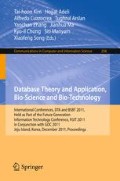Abstract
Patent documents are the results of researched and developed technologies. Patent is a protecting system of inventors’ right for their technologies by a government. Also, patent is an important intellectual property of a company. R&D strategy has been depended on patent management. For efficient management of patent, we need to analyze patent data. In this paper, we propose a method for analyzing international patent classification (IPC) code as a patent analysis. We introduce association rules and maps for IPC code analysis. To verify our improved the performance, we will make experiments using searched patent documents of database technology.
Access this chapter
Tax calculation will be finalised at checkout
Purchases are for personal use only
Preview
Unable to display preview. Download preview PDF.
References
Zhu, D., Porter, A.L.: Automated extraction and visualization of information for technological intelligence and forecasting. Technological Forecastingand Social Change 69, 495–506 (2002)
Coates, V., Farooque, M., Klavans, R., Lapid, K., Linstone, H.A., Pistorius, C., Porter, A.L.: On the future of technological forecasting. Technological Forecasting and Social Change 67, 1–17 (2001)
Mann, D.L.: Better technology forecasting using systemic innovation methods. Technological Forecasting and Social Change 70, 779–795 (2003)
Tseng, Y.H., Lin, C.J., Lin, Y.I.: Text mining techniques for patent analysis. Information Processing & Management 43, 1216–1247 (2007)
Madu, C.N., Kuei, C.H., Madu, A.N.: Setting priorities for IT industry in Taiwan-A Delphi study. Long Range Planning 24(5), 105–118 (1991)
Mitchell, V.W.: Using Delphi to Forecast in New Technology Industries. Marketing Intelligence & Planning 10(2), 4–9 (1992)
Woundenberg, F.: An evaluation of Delphi. Technological Forecasting and Social Change 40, 131–150 (1991)
Yun, Y.C., Jeong, G.H., Kim, S.H.: A Delphi technology forecasting approach using a semi-Markov concept. Technological Forecasting and Social Change 40, 273–287 (1991)
Yoon, B., Park, Y.: Development of New Technology Forecasting Algorithm: Hybrid Approach for Morphology Analysis and Conjoint Analysis of Patent Information. IEEE Transactions on Engineering Management 54(3), 588–599 (2007)
Jun, S., Park, S., Jang, D.: Forecasting Vacant Technology of Patent Analysis System using Self Organizing Map and Matrix Analysis. Journal of the Korea Contents Association 10(2), 462–480 (2010)
Jun, S., Uhm, D.: Patent and Statistics, What’s the connection? Communications of the Korea Statistical Society 17(2), 205–222 (2010)
Hahsler, M., Grun, B., Hornik, K.: arules – A Computational Environment for Mining Association Rules and Frequent Item Sets. Journal of Statistical Software 14(15), 1–25 (2005)
Agrawal, R., Imielinski, T., Swami, A.: Mining Association Rules between Sets of Items in Large Databases. In: Proceedings of the 1993 ACM SIGMOD International Conference on Management of Data, pp. 207–216 (1993)
Agrawal, R., Mannila, H., Srikant, R., Toivonen, H., Verkamo, A.I.: Fast discovery of association rules. In: Advances in Knowledge Discovery and Data Mining. AAAI/MIT Press (1995)
Lerner, J.: The importance of patent scope: an empirical analysis. RAND Journal of Economics 25, 319–332 (1994)
Ernst, H.: Patent applications and subsequent changes of performance: evidence from time-series cross-section analyses on the firm level. Research Policy 30, 143–157 (2001)
Shane, S.: Technological opportunities and new firm creation. Management Science 7, 205–220 (2001)
Nizar, G., Khaled, K., Rose, D.: Supporting Patent Mining by using Ontology-based Semantic Annotations. In: Proceedings of International Conference on Web Intelligence, pp. 435–438 (2007)
Wu, C., Ken, Y., Huang, T.: The Support Vector Machine Classification System for Patent Document Information Importance Analysis. In: Proceedings of International Conference on BioMedical Engineering and Informatics, pp. 375–379 (2008)
Yoon, B., Park, Y.: Development of New Technology Forecasting Algorithm: Hybrid Approach for Morphology Analysis and Conjoint Analysis of Patent Information. IEEE Transactions on Engineering Management 54(3), 588–599 (2007)
Yoon, B., Lee, S.: Patent analysis for technology forecasting: Sector-specific applications. In: Proceedings of IEEE International Conference on Engineering Management, pp. 1–5 (2008)
Brinn, M.W., Fleming, J.M., Hannaka, F.M., Thomas, C.B., Beling, P.A.: Investigation of forward citation count as a patent analysis method. In: Proceedings of Systems and Information Engineering Design Symposium, pp. 1–6 (2003)
International Patent Classification (IPC), World Intellectual Property Organization (WIPO), http://www.wipo.int/classifications/ipc/en/
Han, J., Kamber, M.: Data Mining Concepts and Techniques. Morgan Kaufmann (2001)
Bayardo, Jr, R. J., Agrawal, R.: Mining the most interesting rules. In: KDD 1999: Proceedings of the fifth ACM SIGKDD International Conference on Knowledge Discovery and Data Mining, pp. 145–154 (1999)
R Development Core Team.: R, A language and environment for statistical computing. R Foundation for Statistical Computing (2011), http://www.R-project.org
Hahsler, M., Buchta, C., Gruen, B., Hornik, K.: Package ‘arules’. R-project CRAN (2011)
Hahsler, M., Chelluboina, S.: Package ‘arulesViz’. R-project CRAN (2011)
Author information
Authors and Affiliations
Editor information
Editors and Affiliations
Rights and permissions
Copyright information
© 2011 Springer-Verlag Berlin Heidelberg
About this paper
Cite this paper
Jun, S. (2011). IPC Code Analysis of Patent Documents Using Association Rules and Maps – Patent Analysis of Database Technology. In: Kim, Th., et al. Database Theory and Application, Bio-Science and Bio-Technology. BSBT DTA 2011 2011. Communications in Computer and Information Science, vol 258. Springer, Berlin, Heidelberg. https://doi.org/10.1007/978-3-642-27157-1_3
Download citation
DOI: https://doi.org/10.1007/978-3-642-27157-1_3
Publisher Name: Springer, Berlin, Heidelberg
Print ISBN: 978-3-642-27156-4
Online ISBN: 978-3-642-27157-1
eBook Packages: Computer ScienceComputer Science (R0)

